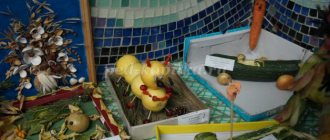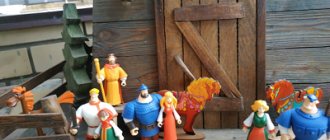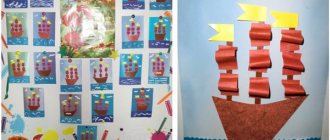“Experimental research activities of preschool children”
“Experimental research activities of preschool children”
From work experience
Derbina Olesya Nikolaevna
teacher
MDOU "D/s No. 7"
Ukhta.
Joy and happiness, health and longevity are necessary for every person, and we wish this for our family, friends and relatives. We rejoice at green grass, a snowy field, singing birds - everything that evokes good feelings. We are indignant and indignant when we encounter something that has a detrimental effect on nature.
To raise children, you must first fill your soul with goodness, happiness, and dreams. My dream is to raise sympathetic, kind, merciful children, to teach them environmentally literate behavior in nature, and a humane attitude towards all living things. Forming such a consciously correct attitude towards nature is a long process, so it is necessary to lay the foundations of environmental literacy as early as possible. I want to share one of the methods for developing a sensitive and caring attitude towards all living things, which we use in working with the children of our group.
Everyone knows that young children are inquisitive. Among the questions they pose to adults are many such as “Why does it rain in autumn and snow in winter?”, “Why does day follow night?” etc., those adults who brush aside the child’s annoying questions do the irreparable: they retard his mental growth, slow down his spiritual development. Our duty is not only to answer children’s endless questions, but also to actively encourage their inquisitiveness so that the number of such questions grows.
How to find out what is happening to each of the objects surrounding the child? Everything must be examined using all analyzers, and all the data obtained is entered into memory. Unfortunately, many adults do not think about the painful sensations that arise in a child when he is deprived of the opportunity to load his memory with various new information.
Organizing elementary experimental research activities in a group will help me awaken the mental abilities of children, introduce them to the world of knowledge of the world around them, and introduce them to the beauty of nature. Since in children of the first seven years of life, thinking is visually effective and visually figurative, and not verbally logical, the pedagogical process in kindergarten should be based on practical and visual methods. Natural phenomena and objects provide many opportunities for this. Therefore, when working with children, I pay a lot of attention to organizing and conducting experiments with objects of living and inanimate nature. The leading idea of the experience of my work is the formation of a harmoniously developed personality of a preschooler through the use of the method of children's experimentation because, as it turned out, experiments and experiments have a positive effect on the emotional sphere of the child, on the development of his creative abilities, they give
children have real ideas about the various aspects of the object being studied, its relationships with other objects and with the environment. In the process of experiments, the child’s memory is enriched, his thought processes are activated, because There is a constant need to perform operations of analysis and synthesis, comparison and classification, generalization and extrapolation.
The need to give an account of what is seen, to formulate discovered patterns and conclusions stimulates the development of speech. The consequence is not only the child’s familiarization with new facts, but also the accumulation of a fund of mental techniques and operations that are considered as mental skills.
Children's experimentation is closely connected with other types of activity - observation, speech development (the ability to clearly express one's thoughts makes it easier to carry out experiments, while the addition of knowledge contributes to the development of speech.) The connection between children's experimentation and visual activity is also two-way. The more strongly a child’s visual abilities are developed, the more accurately the result of a natural history experiment will be recorded. At the same time, the more deeply a child studies an object in the process of becoming familiar with nature, the more accurately he will convey its details during visual activity.
The connection between experimentation and the formation of elementary mathematical concepts does not require special proof. During the experiment, the need to count, measure, compare, determine shape and size constantly arises. All this gives mathematical concepts real significance and contributes to their understanding. At the same time, mastery of mathematical operations facilitates experimentation.
During my work, I set myself the following tasks:
- Deepen children's knowledge about the natural objects and natural phenomena around them;
- To develop cognitive interest in nature, speech, thinking, memory, the ability to formulate conclusions, mathematical skills, to promote the development of an understanding of the correct picture of the world;
- Cultivate accuracy, the ability to listen to an adult, patience, and caring attitude toward all living things.
In a kindergarten setting, I use only elementary experiments. Their elementary nature lies, firstly, in the nature of the problems being solved: they are unknown only to children, secondly, in the process of these experiments no scientific discoveries occur, but elementary concepts and conclusions are formed, thirdly, in such work ordinary everyday and playful things are used equipment (disposable tableware, plastic bags, etc.)
Elementary experiences can be very different. These are experiments with objects of animate and inanimate nature, which can be carried out in a group room during ecology classes and outside of class, on walks around the kindergarten site, or in a flower garden.
When conducting experiments, I adhere to the following structure:
1. Motivation
2. Statement of the problem;
3.Search for ways to solve the problem;
4.Conducting observations; 5. Discussion of the results seen;
6.Formulation of conclusions.
Experiments can be individual or group, single or cyclic (a cycle of observations of water, the growth of plants placed in different conditions, etc.). In winter, children plant green onions, garlic, oats and vegetable seedlings on the windowsill.
Experiences may vary:
- By the nature of mental operations (stating, allowing you to see the dynamics of the process and generalizing, which allow you to trace the general patterns of the process previously studied at certain stages).
- By method of application.
They are divided into demonstration and frontal. The demonstration is carried out by the teacher, and the children monitor its implementation. These experiments are carried out when the object under study exists in a single copy, when it cannot be given into the hands of children, or when it poses a certain danger to children (for example, when using a burning candle). In other cases, it is better to conduct frontal experiments, since they are more consistent with the age characteristics of children.
Ecological experiments have features that must be taken into account. Thus, experiments that harm plants and animals are strictly prohibited (you cannot collect collections of insects, you cannot conduct experiments on some animals eating others, etc.). Sometimes you have to pick up an animal or insect (for example, an earthworm) and bring it to kindergarten to conduct experiments. At the same time, we try to reduce the time he spends in the group to a reasonable limit and after the end of the experiment, we must return him to the place from which he was taken.
Particular attention must be paid to safety rules and hygiene issues. When conducting natural science experiments, it happens that the actual results do not coincide with the expected ones. In such cases, it is necessary to discuss with the children the result that was obtained in real life, which is often more interesting than planned.
Children's experimentation has its own characteristics. It is free of obligations; the duration of the experience cannot be strictly regulated. It is necessary to take into account the fact that it is difficult for preschoolers to work without speech accompaniment (since it is in older preschool age that visual-figurative thinking begins to be replaced by verbal-logical thinking, inner speech begins to form, children go through the stage of pronouncing their actions out loud), such individual differences must be taken into account that exist between children, one should not get too carried away with recording the results of the experiment; it is necessary to take into account the child’s right to make mistakes and use adequate ways to involve children in work, especially those who have not yet developed skills (working with children’s hands, splitting one procedure into several small actions assigned to different children, joint work of the teacher and children, help from the teacher to children, work of the teacher at the direction of the children (for example, during demonstration experiments), conscious admission by the teacher of inaccuracies in the work, etc.). At any age, the role of the teacher remains leading. Without it, all experiments turn into aimless manipulation of objects, incomplete with conclusions and without cognitive value.
The teacher must behave in such a way that the children feel as if they are working independently. When working with children, one should try not to draw a clear line between everyday life and learning, because experiments are not an end in themselves, but a way of getting to know the world in which they will live. It is also necessary to take into account the peculiarities of experimentation in different age groups.
Educators and psychologists believe that the early beginnings of experimentation date back to the age when a child first reached out to a rattle. From this moment on, he begins to unconsciously manipulate objects, and his analyzers record all events.
Already in the first junior group, manipulation begins to resemble experimentation; children are already able to follow the simplest instructions, and they can be asked to answer the simplest questions.
Children of the second younger group should try, if possible, not to impart knowledge in a ready-made form, but to help the child obtain it independently by performing a simple experiment. In this case, the child's question turns into formulated goals. Children at this age are already able to establish the simplest cause and effect relationships. The participation of the teacher in any action is mandatory.
Children in the middle group begin to make their first attempts to work independently, but visual control from an adult is necessary to ensure safety and for moral support, since without constant encouragement and expression of approval, the activity of a four-year-old child quickly fades. In this age group, experiments can be carried out to determine the causes of individual phenomena; children study the properties of water, snow, and sand.
For children in the older group, more complex chains of cause and effect relationships become available. We should try to ask them the question “Why?” at this age more often. Very often they ask it themselves, which indicates certain shifts in the development of logical thinking. In this group, long-term experiments can be introduced, as well as simple monitoring (for example, to determine the level of air pollution on the site and in the preschool premises). Children continue to study the properties of water, snow, sand, soil, clay, learn about the properties of air, conclude that there is no such thing as bad weather, that plants and animals need snow in winter, study the water cycle using the example of indoor plants, and become familiar with the influence of factors environment on living organisms.
In the preparatory group, children are already trying to put forward some hypotheses, they are able to draw conclusions about the hidden properties of objects and phenomena, often they already make these conclusions on their own and even without leading questions. Children will learn why day and night change each other, seasons, where the hottest and coldest places on our planet are, why stars are not visible in the sky during the day, learn through experimental activities about the natural features of some climatic zones (permafrost in the tundra, tropical rainfall, etc.), continue to study the influence of the environment on living organisms, get acquainted with the adaptations of organisms to their environment, study the impact of human activity on natural communities (oil spills in the sea, digging up soil, etc.)






